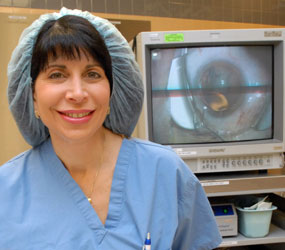LASIK surgery still can sound intimidating to a lot of people. The procedure involves cutting a flap into a person’s cornea so a laser can be used to vaporize part of the cornea’s midsection. The surgery permanently changes the shape of the clear section of the front of the eye in order to eliminate or reduce the need for glasses or contact lenses.
Dr. Sheri Rowen, director of the Eye and Cosmetic Surgery Center at Mercy Medical Center in Baltimore, said there have been numerous advances in the last 10 years that have improved outcomes for patients considering LASIK (an acronym for laser-assisted in-situ keratomileusis) “The lasers themselves that create the treatment are significantly better,” Dr. Rowen said. “There have been some advances in customizing treatment for the shape of a person’s cornea. When we do certain measurements, we can plug that information into the computer and it knows how to treat better so that we do not have the glare or halo issues, the vision correction is better and there’s less regression of treatment.”
Ideal candidates for LASIK surgery are those between the ages of 20 and 40, Dr. Rowen said, although older patients may also be treated successfully. The procedure is geared toward nearsighted, farsighted and patients with astigmatism, she said.
Prior to surgery, patients undergo full eye exams that involve inspection of the shape of their corneas. Dr. Rowen encourages those who use contact lenses to be especially open to exploring LASIK surgery since long-term use of contact lenses can damage the cornea.
“Anyone who wears contact lenses for a prolonged period of time can also have difficulty with dry eye,” Dr. Rowen said.
While LASIK surgery is considered a common procedure, Dr. Rowen noted that there is always the risk that vision may not be corrected perfectly or that a patient may suffer side effects like dry eye or halos and other obstacles in their vision.
“Thank God that’s so rare today,” she said. “It’s diminished significantly.”
Dr. Rowen said most patients will notice “instant” improvement in their vision immediately following surgery, which takes a few minutes. She noted that some insurance companies cover the expenses of LASIK surgery. Without insurance, the procedure costs approximately $4,000-$5,000.
Before having LASIK surgery, the U.S. Food and Drug administration recommends that patients compare surgeons, their levels of experience with particular LASIK treatments and the kinds of devices they use. Decisions should not be based on cost or guarantees that 20/20 vision can be restored, according to the FDA.


